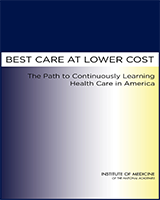From: 4, Imperative: Capturing Opportunities from Technology, Industry, and Policy

NCBI Bookshelf. A service of the National Library of Medicine, National Institutes of Health.
Although there has been an increase in the clinical knowledge being produced (see Chapter 2), the necessary evidence is lacking in many areas. However, the increased use of electronic medical records provides an opportunity to expand the evidence base on which clinicians can draw, especially in the absence of published data. For example, a group of pediatricians was treating a 13-year-old girl with systemic lupus erythematosus (SLE). Her autoimmune disease was complicated by conditions that put her at risk for blood clots, and her physicians considered the administration of an anticoagulant as a preventive measure. However, the physicians could not find any evidence (either peer-reviewed literature or expert opinion) pertaining to the patient's situation. Given the need to make a decision quickly, they reviewed the medical records from their institution, collating the records of 98 other pediatric SLE cases handled by their division in the past 5 years. Based on these data, they conducted a cohort review and ascertained that children with similar complicating conditions had been more likely to develop blood clots. They then recommended anticoagulant use within 24 hours of the patient's admission. The patient did not develop blood clots or experience any anticoagulant-related complications. Although this form of data review does not eliminate more extensive clinical research protocols, the data in the electronic medical records allowed a real-time clinical decision to be made based on the best available data, an approach that holds promise for larger-scale use.
SOURCE: Frankovich et al., 2011.
From: 4, Imperative: Capturing Opportunities from Technology, Industry, and Policy

NCBI Bookshelf. A service of the National Library of Medicine, National Institutes of Health.